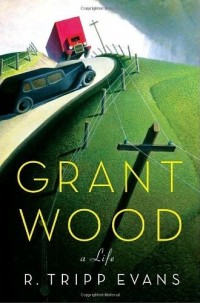 As much art criticism as biography, this new life of Grant Wood attempts to return a once-celebrated artist to his rightful place as a major figure in twentieth century American art. While American Gothic remains an enduring monument, Wood’s other work has fallen into some obscurity.
As much art criticism as biography, this new life of Grant Wood attempts to return a once-celebrated artist to his rightful place as a major figure in twentieth century American art. While American Gothic remains an enduring monument, Wood’s other work has fallen into some obscurity.
Wood was born in 1891 in a small Iowa farming community. The son of a strict Quaker who banned fairy tales and children’s literature from the home, the imaginative and unathletic boy had the further misfortune of growing up in an era when masculinity was undergoing a strict redefinition by the culture at large. Child-rearing experts of the day deplored kindness to animals as unmanly, and an interest in books, music, and art were taken as signs that a boy dwelled too much in the feminine sphere. Wood’s mother, meanwhile, provided him with a private space beneath the kitchen table where he could draw his pictures unseen. He was ten when his father‘s death made such subterfuge unnecessary.
Evans makes much of these beginnings, scrutinizing a lifetime’s worth of paintings through a distinctly Freudian lens. The index is replete with entries referring to castration, impotence, and incest ― instances of Wood’s private and (Evans acknowledges) perhaps unconscious iconography. The subject of Victorian Survival, a portrait in which Wood endows his great aunt with an elongated neck and velvet choker, “embodies a tumescence that can be maintained only by a choking cock ring.” Writing about Parson Weems’ Fable, which depicts the young George Washington, his father, and the cherry tree, Evans points out that Washington’s hatchet aims at his father’s shadow at the level of the genitals. The slaves in the background symbolize mother-son incest ― a reflection of Wood’s guilty loyalty to his mother. The slaves’ skin color is, moreover, a reference to Wood’s father, as it “evokes the color of death.” The rolling hills of Wood’s landscapes are invariably a fetishistic representation of male buttocks, and phallic symbols occur everywhere.
Lest the reader think this is all too much, Evans turns defensive, writing, “I would argue that such a reaction only highlights our conscious resistance to the psyche”s raw and anarchic operations. My readings attempt to record what I perceive in Wood‘s mind‘s eye.”
The discussion of Wood’s place at the forefront of the Regionalist movement of the 1930s is more illuminating. Upheld in some quarters as the very embodiment of wholesome rural American ideals, he was praised in others as an irreverent satirist skewering those same ideals, the visual equivalent of H. L. Mencken. A public acknowledgment of his homosexuality would have meant disaster, and when fellow Regionalist Thomas Hart Benton ranted in print against the “pansies” and “precious fairies” who had taken over the New York art establishment, Wood fell into line and commended Benton’s remarks as “healthful commentary.”
Throughout Grant Wood: A Life, Evans relies on Wood‘s unfinished autobiography and the memoirs of the artist‘s sister where they conform to his surmises, and dismisses them where they do not. Ultimately, it seems that Grant Wood has been made to serve someone else’s purposes once again.
Includes 26 color plates, 88 black and white illustrations, 62 pages of notes, an index, and a bibliography.
Recommended for libraries with a strong interest in American art or with extensive GLBT collections.
Reviewed by, Joyce Meggett
Division Chief for Humanities
Chicago Public Library
